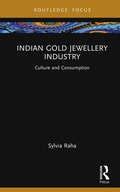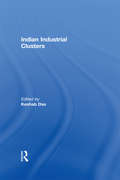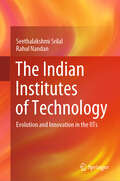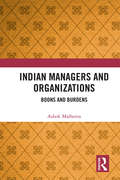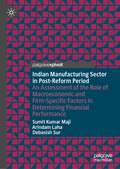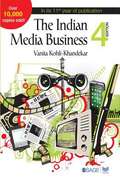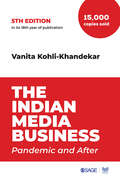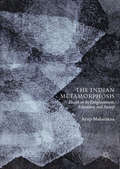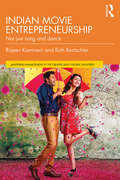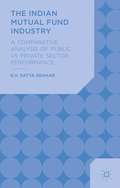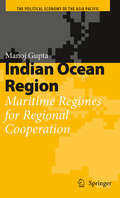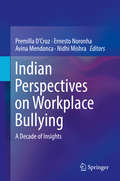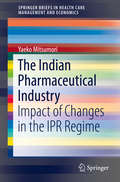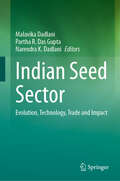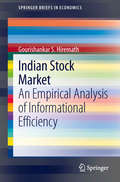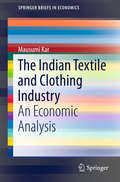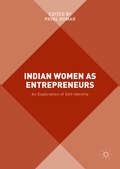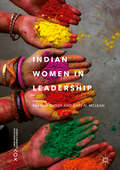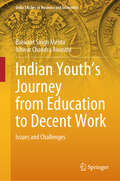- Table View
- List View
Indian Gold Jewellery Industry: Culture and Consumption (Routledge Focus on Management and Society)
by Sylvia RahaIndia has a long-standing cultural and societal affinity with gold and gold jewellery. Gold metaphorically represents the sacredness, purity and immortality that bind religious beliefs and culture together. Accumulation of gold is associated with material and non-material cultures where the perceptions, attitudes and experiences of the members engaged in production and consumption are bound into a complex relationship. The idea of the book initially originated from the course of research work. It was found that India has the largest unorganised jewellery industry, in terms of manufacturing and consumption unit. Jewellery fabrication in India is not just a profession for the jewellers, but it has been a family tradition extending across generations. Gold jewellery makers (sunnar, swarnakars) are the spine of the jewellery industry. They acquired the skill of making jewellery from the experienced and learned gold smithery (karigars), either from their ancestors who were engaged in this business or from the craftsmen-cum-petty traders. The co-relations of castes, religion, culture, economy and class are intertwined with each other in such a way that made the gold jewellery industry sustainable. Surprisingly, there is an absence of literature on understanding the structural and functional aspects of the gold jewellery industry in India.This book explores the roles of sunars/swarnakars (goldsmith or jewellery makers), consumers, trade and the policies that bring a change in the gold jewellery industry in India and India’s position in the global market scenario. By focusing on their way of life, the book brings unique insights into the social and economic experience of the unorganised gold jewellery sector and the role of consumers in production.
Indian Industrial Clusters
by Keshab DasThis book presents an in-depth analysis of the functional dynamics of Indian industrial clusters which have grown and stayed as hubs of business activity in India, thanks to a large calibrated domestic market for goods. The examples given contribute towards the understanding of theoretical underpinnings of small firm clusters in LDCs and also indicate steps towards effective policy making for SME development in general, and local economic regeneration in LDCs in particular. The industries studied include modern as well as traditional/artisanal sectors which span at least ten Indian states. They provide insights into informality, labour, inter-firm relationship (cooperation and competition), technological and organisational flexibility, and forms of supportive institutional arrangements and nature of linkages with agencies external to the cluster, among other things. This book will be of particular interest to SME practitioners and to students and researchers of economics, business management, regional development, economic geography, industrial sociology and industrial organisation.
The Indian Institutes of Technology: Evolution and Innovation in the IITs
by Seethalakshmi Srilal Rahul NandanThis book aims to bring forth the achievements and innovations from the Indian Institutes of Technology (IITs). The IITs are premier institutes of engineering and technology education and research in India. This book showcases the evolution of IITs and highlights their role as incubators of innovation, research and entrepreneurship. From creating India's Air Quality Index to research in earthquake mitigation and nanotechnology to cutting edge innovations across engineering disciplines, this volume highlights the achievements of these decades old Indian institutions. Written by experienced journalists after years of research, interviews and conversations with academic and institutional leaders, the book weaves together a story of the IITs and their pivotal role in transforming teaching, learning, research and innovation that drives the progress of technology in India. Written in a manner accessible to a general audience, the book will be of interest to a broad spectrum of readers, including researchers, students, institutional leaders, policy makers, and the general public.
Indian Managers and Organizations: Boons and Burdens
by Ashok MalhotraCulture is critical to individuals and organizations. This book takes a close look into the way Indian managers work, their inner struggles, and forces that shape their behaviour. It presents an original framework developed by the author — the Existential Universe Mapper (EUM), a pluralistic and non-reductionist model of management that uses a new psychometric instrument to map individual and organization identity. The model restrains from placing any phenomenon into frozen categories and enables an understanding of their interplay. The volume points to India’s ambivalent relationship with modernity, and the consequent difficulty of Indian managers in embracing the imperatives of the corporate world that are largely based on Anglo-Saxon frames. This book will be of interest to those in business management, human resource management, leadership studies, corporate governance, industries, education, social sector, governance, psychology, and sociology. It will be particularly relevant for scholars, educators, consultants, practitioners of management and corporate leaders.
Indian Manufacturing Sector in Post-Reform Period: An Assessment of the Role of Macroeconomic and Firm-Specific Factors in Determining Financial Performance
by Sumit Kumar Maji Arindam Laha Debasish SurThe book outlines the importance of Indian manufacturing sector and its growth under alternative policy regimes. The authors highlight the significance of various firm-specific and macroeconomic factors on the level of efficiency and profitability of the firms operating in the diverse manufacturing sector during the post-liberalization era. The book also examines the dynamic relationship between the select manufacturing sector-specific stock market indices and the various macroeconomic variables.
The Indian Media Business
by Vanita Kohli-KhandekarThe Indian Media Business, Fourth Edition gives you detailed analysis, perspective and information on eight segments of the media business in India--print, TV, film, radio, music, digital, outdoor, and events. It presents the business history, current dynamics, regulation, economics, technology, valuations, case studies, trends (Indian and global) and a clear sense of how the business operates. This book is a must-read for media professionals, students and for those planning to invest in the Indian media and entertainment business. The outstanding feature of the fourth edition is a new chapter on digital media--arguably, the first ever look at digital media from a comprehensive business perspective. This looks at everything from history to business dynamics and the major issues digital media faces in India. This edition tackles regulation with more detail than any of the previous ones. There is one large case study on the quality of regulation in India and several caselets such as the ones on copyright law, defamation law and how it works for social media. This edition also contains more caselets than the previous editions. There are caselets on the changes in readership methodology, on the trouble with news broadcasting and on the rising power of Hindi newspapers and the impact of digital on both print and TV among others.
The Indian Media Business: Pandemic and After
by Vanita Kohli-KhandekarAre Google and Facebook news or entertainment companies? Is Netflix a studio or an aggregator? As media, technology and telecom merge into one simple search for audiences, what really is a media company? How has on-demand viewing changed the way we watch, listen or read? Can Indian cinema survive the devastation that the pandemic has wrought? The fifth edition of The Indian Media Business: Pandemic and After delves into each of these questions as it cuts across print, TV, film, music, radio and digital media. In the process, the book takes you through the current trends, history, business dynamics and regulation in media, and provides a glimpse into the future of each of these segments.
The Indian Metamorphosis: Essays on Its Enlightenment, Education, and Society
by Arup MaharatnaThis book examines various ideational, attitudinal and intellectual impasses that are becoming glaringly apparent on several fronts, and which have held back India’s balanced, steady and uniform development and transformation post-independence. It argues that all of these ideational and attitudinal aberrations stem from one basic fact, namely that India, throughout the entire period since the onset of modern industrial secular civilization at the global level, has somehow managed to evade the core ideas and values of the western Enlightenment movement, leaving unfinished the crucial task of modernizing and secularizing the mindsets and outlooks of its people on a mass scale – a task that has historically and globally been the backbone of sustained modern material development with socio-political stability. Further, it suggests that this enormous failure is crucially linked to key shortcomings in Indian mainstream thinking, and the imaginations and visions in general, and as such is also linked with confused educational ideas and content – particularly at the elementary level – since the country gained independence. The book maintains that Indian curricula and educational content at the school level has been consciously designed to guard against the core values and ideas of the Enlightenment, which could have made the typical Indian mind more rational, reasonable, mature and secular, resulting in much lower degrees of unreason, raw sentiments and emotions than have been hitherto entrenched in it. The book further sketches the genesis and impact of the currently dominant neoliberal ideas and thinking that have invaded the entire educational universe and its philosophy around the world. Lastly, it examines and assesses the latter’s far-reaching ramifications for current Indian educational philosophy, pedagogy and practices, and proposes concrete remedial directions for public policy and action.
Indian Movie Entrepreneurship: Not just song and dance (Discovering the Creative Industries)
by Rajeev Kamineni Ruth RentschlerOne of the world’s most prolific creative industries, the Indian movie industry has received scant attention for its spirit of enterprise. Indian Movie Entrepreneurship addresses this omission. For many readers, it might come as a surprise that the Indian movie industry is not just Bollywood and that it has several regional clusters, which are just as vibrant, with a significant output. The authors begin by outlining the contours of Indian cinema and the different regional language hubs that form part of the larger picture. The reader is then offered a glimpse into the actual process of making a film from day zero to release day. The key players in the Indian movie ecosystem are analysed, with the central role of the producer highlighted. Concluding with a look into the future of the entrepreneurial process in the Indian movie industry, the authors illuminate the shifting parameters of distribution and exhibition. Appealing to those interested in understanding the entrepreneurial journey of the Indian movie industry, the book provides a sneak peek into the business landscape of India more broadly.
The Indian Mutual Fund Industry
by Satya SekharDr. Sekhar offers comprehensive knowledge on the mutual fund industry in India and provides ready-made practical information for investors. He presents an overview of investment patterns for both public and private sector mutual funds, and analyses the performance of selected schemes using various measures of risk.
Indian Ocean Region
by Manoj GuptaThe Indian Ocean region is arguably one of the world's least understood, yet its importance in geopolitics and international relations is greater than ever before. This book explores the concepts of regime theory, regional orders and ocean governance to critically assess the effectiveness of maritime regimes, something that not been attempted before for the Indian Ocean Region. This study employs the theoretical framework of international regimes in the context of ocean governance by developing a new model, which is used to test the regimes' effectiveness. This book addresses the analytical gap in our understanding about the strategic importance of the Indian Ocean as a region in contemporary world geopolitics and international relations. Case studies display the groundwork for regional cooperation in the maritime realm laid by Indian Ocean countries, and the effectiveness of current political leadership is addressed. There is considerable value in looking at the Indian Ocean as a region for future analysis of maritime regimes, and this book proposes that international maritime regimes can expand regional cooperation in the Indian Ocean to create a new geopolitical region. The interdisciplinary approach presented draws on historical analysis, international maritime law, political science, international relations and the literature on regime theory and will be of interest to academics in those fields as well as policy-makers concerned with maritime issues.
Indian Perspectives on Workplace Bullying: A Decade of Insights
by Premilla D'Cruz Ernesto Noronha Avina Mendonca Nidhi MishraThis book, recognizing that workplace bullying is a significant employment relations and occupational health and safety problem in India which warrants urgent and holistic intervention, presents empirical studies examining contextual factors, antecedents, mediators, moderators, processes, outcomes and solutions, thereby deepening our understanding of the phenomenon. The chapters showcased in the volume emphasize the paradoxical Indian sociocultural ethos whose simultaneous embrace of humanism versus identity-based, personalized and hierarchical relationships, materialism versus spiritualism and individualism versus collectivism both fuel yet quell misbehaviour. The inquiries which constitute this book engage both positivist and postpostivist paradigms, draw on several theoretical and substantive frameworks, utilize an array of methods, investigate numerous foci and cover various geographical regions in India, a range of industrial sectors and all levels of the organization. In so doing, they make pathbreaking contributions beyond country-specific insights to advance the frontiers of the thematic area worldwide. The chapters include important findings pertaining to digital workplaces, child labour, forgiveness, customer bullying, psychological contract violation, perceived organizational support, psychological capital and comprehensive prevention strategies encompassing psychosocial risks. As well as building on a decade of knowledge about workplace bullying in India, the book puts forward a research agenda on the topic for the subcontinent in particular and the field in general. The volume is of interest to researchers, practitioners and students of organizational studies, human resource management, industrial relations, labour law, corporate law, health sciences and social work.
The Indian Pharmaceutical Industry: Impact of Changes in the IPR Regime (SpringerBriefs in Health Care Management and Economics)
by Yaeko MitsumoriThis study analyzes the impact of the revision of the Indian Patent Act (2005) on the Indian pharmaceutical industry, which has been achieving healthy growth over the past 30 to 40 years or more. As of 2005, the Indian pharmaceutical industry was ranked as No. 4 in the world in terms of volume and 15th in terms of value. WTO/TRIPS required India to revise its patent law, however, and to introduce product patents in the pharmaceutical field. Many not only in India but also in the world had argued that the local pharmaceutical industry could deteriorate once a strong patent law (such as a product patent) was introduced. However, the Indian pharmaceutical industry has continued to develop rapidly even after the revision of the patent law in 2005. This present study started with efforts to work out the reason the Indian pharmaceutical industry successfully expanded even after the introduction of product patents. The study found that a unique article (the so-called '3-d‘) inserted in the Patent Act 2005 might have played a role in diminishing or preventing a negative impact from the introduction of a strong patent system, such as a product patents. The study also considers that a change of the business model adopted by the Indian pharmaceutical industry might have contributed to diminishing the effect of the negative impact from the introduction of a strong patent law. This study also covers recent developments in India regarding intellectual property rights and the pharmaceutical industry. One is India’s very first compulsory license granted to an Indian pharmaceutical company, Natco, against the large German pharmaceutical firm Bayer; and the second is the Supreme Court decision on Novartis’ Gleevec. The study analyzes the fundamental problems that caused these two events: access to medicine and gaps in the concept of intellectual property in the pharmaceutical industry. As possible solutions to these fundamental issues, this book explores the ideas of voluntary licensing and tiered pricing.
The Indian Premier League, 2020
by John R. Wells Benjamin WeinstockSince its founding in 2008, the Indian Premier League (IPL), India's eight-week Twenty20 (T20) cricket competition, had become one of the most popular and lucrative sporting leagues in the world. In 2019, the IPL attracted 462 million TV viewers and 300 million digital viewers, and the total IPL ecosystem was estimated to be worth $6.8 billion. Key to the IPL's success was its league structure, which shared central revenues with its eight permanent franchises, set strictly enforced salary caps, and ensured transparent player purchasing. The basic logic was that these steps would maximize the level of competition throughout the league, making each match an unpredictable and unmissable event, which, in turn, would grow the value of the league's media rights. Equally important was the league's conscious efforts to market itself as entertainment for the whole family. Besides high-stakes cricket, IPL matches featured everything from dancing and singing to fireworks and fan competitions. This "integration of Bollywood and cricket" expanded the league's addressable market from what was traditionally a sport dominated by male viewers; indeed, 42% of the IPL's TV audience were women. The net result of these decisions was that the IPL was one of only two professional sports leagues in the world - the other was the National Football League (NFL) in the United States - in which all teams were profitable. The IPL's rise seemed unstoppable, but then, on April 15, 2020, the Board of Control for Cricket in India (BCCI) announced that the IPL would be postponed indefinitely due to the novel coronavirus pandemic. There was little doubt that the pandemic would have financial repercussions for the league and its teams. However, some viewed it as an opportunity to rethink how the league was positioning itself to navigate the major changes underfoot in the world of sport - from how fans engaged with their favorite teams and players to the rise of esports and sports betting.
Indian Railways: Building a Permanent Legacy?
by Aldo Musacchio Tarun Khanna Rachna TahilyaniThe main objective of the case is to discuss the political constraints that managers of state-owned enterprises face when trying to do reforms or major turnarounds. Indian Democracy offers an interesting setting to study the relationship between electoral politics and managerial performance in the largest state-owned company in the world: Indian Railways.
The Indian Removal Act and the
by Ari Medoff Raven Smith Tom NicholasNative Americans were subjected to a protracted and painful process of forced removal from their land. The case provides "first hand" evidence on the debate over Indian removal as it took place during the early nineteenth century. The first document is excerpted from Andrew Jackson's First Annual Message to Congress in 1829 and the second document from Jackson's Second Annual Message in 1830, the year the Indian Removal Act was passed. The third and fourth documents cover the Congressional debate over the relocation of Indians, which led to strong partisan splits and divisions between the North and the South. Document three is excerpted from Whig Senator Theodore Frelinghuysen of New Jersey's six-hour speech to Congress opposing Indian removal. Document four is excerpted from a speech by Senator John Forsyth, a Democrat and former Governor of Georgia who spoke in response to Senator Frelinghuysen's remarks. A final document presents the Cherokee perspective and the reasons for their opposition to removal as represented by a memorial letter, written to the United States Congress in 1829. A statistical portrait follows the documentary evidence.
Indian Seed Sector: Evolution, Technology, Trade and Impact
by Malavika Dadlani Partha R. Das Gupta Narendra K. DadlaniThis book provides an insight into the growth of the Indian seed industry in the past 60 years. It analyzes the socio-economic parameters, complexities, diversities, and need for a strong seed system with appropriate regulatory frameworks in the Indian agrarian economy. The role of rich biological resources and development of a scientific plant breeding system, which laid the strong foundation of the seed sector is discussed. While outlining the growth of a multi-crop and multi-dimensional seed industry, this book examines the role of breeders and seed industry, and rights of farmers, changing regulatory framework governing the seed sector, and impact of inter-governmental conventions, agreements and treaties in regulating the seed sector. Role played by the public and private partners in the establishment of seed sector with science-led technologies and capacity building, and expansion of the domestic seed industry is emphasized. The impact of seed system development with limitations and future prospects is also discussed with a view of a global seed scenario. This book has a wide base of readership including seed industry professionals, policy makers, academicians, researchers and students.
Indian Software Industry in 2002
by Pankaj GhemawatThe Indian software industry, growing at more than 50% per annum and largely dependent on exports of services and products, is one of the few industries in that country considered to be globally competitive. This note allows a discussion of the uses and limits of frameworks for assessing geographic influences on globalization potential. Also permits a discussion of the strategic imperatives for leading competitors within the industry if they are to create company-specific advantages rather than geographic ones.
Indian Stock Market
by Gourishankar S. HiremathIndia is one of the major emerging economies of the world and has witnessed tremendous economic growth over the last decades. The reforms in the financial sector were introduced to infuse energy and vibrancy into the process of economic growth. The Indian stock market now has the largest number of listed companies in the world. The phenomenal growth of the Indian equity market and its growing importance in the economy is indicated by the extent of market capitalization and the increasing integration of the Indian economy with the global economy. Various schools of thought explain the behaviour of stock returns. The Efficient Market Theory is the most important theory of the School of Neoclassical Finance based on rational expectation and no-trade argument. The book investigates the growth and efficiency of the Indian stock market in the theoretical framework of the Efficiency Market Hypothesis (EMH). The main objective of the present study is to examine the returns behaviour in the Indian equity market in the changed market environment. A detailed and rigorous analysis, made with the help of the sophisticated time series econometric models, is one of the key elements of this volume. The analysis empirically tests the random walk hypothesis and focuses on issues like nonlinear dynamics, structural breaks and long memory. It uses new and disaggregated data on recent reforms and changes in the market microstructure. The data on various indices including sectoral indices help in measuring the relative efficiency of the market and understanding how liquidity and market capitalization affect the efficiency of the market.
The Indian Textile and Clothing Industry
by Mausumi KarThis book examines the textile and clothing Industry of India and its trade scenario from a global perspective. New developments in international policies related to trade and investment and falling barriers to trade worldwide as well as within individual regional communities have transformed the structure of production and global competition in the textile and apparel industries across the world. Furthermore, with the incorporation of textile trade in the GATT framework following the removal of quantitative restrictions, and the subsequent liberalization of investment opportunities, the Indian market is now home to several international brands, which has led to the present upsurge of FDI in this very important sector of the Indian economy. The book closely examines the nature and impact of such external changes on the industry's structure and labour-related issues. The key feature of this book is that it presents a snapshot of all the domestic and international policies related to this sector, from the earliest relevant period to the present, and analyses the topical issues in significant detail. The book also offers some empirical analyses to show the impact of external changes on the concentration of firms in this industry and the regional inequalities that have emerged from regional variations in firms' employment, labour-income and profit levels. Further, it addresses another striking feature, namely the role of preferential trading blocs or Regional Trading Arrangements (RTA) in creating trade-diverting effects related to this sector apart from the implications of foreign collaborations and cross-border mergers and acquisitions. Many economists fear that the benefits of these RTAs for the partner countries are much greater than those for India, with net gains of incremental exports from India being small or even negative. This book discusses these critical issues in the context of India's textile and apparel trade.
Indian Women as Entrepreneurs
by Payal KumarThis unique edited collection explores the ways in which entrepreneurship acts to shape self-identity for Indian women and validate their identities in a patriarchal society. Differing from existing literature which focuses on the antecedents of entrepreneurship for women and their performing outcomes, Indian Women as Entrepreneurs questions whether entrepreneurship is simply about exploiting a business opportunity for profitability. Asserting that both work and societal environments have an impact on an entrepreneur's self-identity, this book demonstrates ways in which self-concept influences the entrepreneur's relationship with their work in terms of motivation, effort and performance. Building on Unveiling Women's Leadership, this book provides an original and important contribution to the literature on entrepreneurial Indian women.
Indian Women in Leadership (Current Perspectives on Asian Women in Leadership)
by Rajashi Ghosh Gary N. McLeanThis book provides intriguing insights into the development of highly qualified women leaders in diverse Indian contexts and their role at national and organizational levels. While India has made enormous economic strides in the past few decades, gender inequality and underutilization of female talent remain deeply rooted and widely spread in many parts of Indian society. This book addresses an urgent need to stop treating Indian women as under-developed human capital and begin realizing their potential as leaders of quality work. This book will fill the gap of research on international leadership for students, academics, and multinational organizations.
Indian Youth’s Journey from Education to Decent Work: Issues and Challenges (India Studies in Business and Economics)
by Balwant Singh Mehta Ishwar Chandra AwasthiThis book delves into the intricate challenges faced by Indian youth as they enter the labour market. It explores vital aspects of youth's journey from school to the labour market, offering insights into the current status and strategies for harnessing the demographic dividend, bridging the gap between labour market demand and supply, addressing the issue of skill mismatch, and tackling the challenge of inactive or idle youth in India. The book draws from analysing a diverse range of data sources, including statistics from organizations like the International Labour Organization (ILO) and the World Bank&’s World Development Indicators (WDI); as well as data from surveys such as Periodic Labour Force Survey (PLFS) and Employment-Unemployment Survey (EUS), conducted by the National Sample Survey Office (NSSO) of the Ministry of Statistics and Programme Implementation (MoSPI), Government of India; and educational surveys such as Unified District Information System for Education (UDISE), All India Survey on Higher Education (AISHE), School Education Quality Index (SEQI) and NSSO's surveys on Household Social Consumption: Education. These data cover a period spanning of over two decades, from 2000 to 2023. The book is a valuable resource for policymakers, researchers, and anyone interested in understanding the complex challenges and opportunities associated with the transition of Indian youth from school to decent employment. This transition is closely linked to the achievement of Sustainable Development Goals (SDG) 4 and 8; and with India being home to the world&’s largest youth population, the book showcases aspects of a critical area of focus for organizations and entities working towards these global objectives.
Indianapolis: Activity-Based Costing of City Services (A)
by Robert S. KaplanA new administration in the City of Indianapolis is initially determined to privatize many municipal services. Before taking this action, however, the city managers want to know the current cost of performing these services with the municipal workers. Existing financial systems record how much the city has been spending by functional categories and departments, but contain no information about the cost of providing services. The city establishes a task force to develop activity-based (ABC) estimates of the cost of filling potholes. It shows the information to the municipal workers and allows them to institute new cost-saving procedures so they can submit their own bid in competition with private contractors. This case describes the development of the ABC model and the reaction of the city workers to the newly revealed information.
Indianapolis Beer Stories: History to Modern Craft in Circle City Brewing (American Palate)
by Amy BeersIndianapolis Beer Stories is a time capsule of tales from the city's early taverns, to a pre-Prohibition golden era, to today's modern craft beer scene.Meet the ghosts of Indy's brewing past. Discover the very beginning of beer in Indiana's new capital and the pioneers who carved a path for a future industry. Uncover the legacy of a bygone brewing giant. Learn how one spontaneous decision to cross the treacherous Rocky Mountains led to a booming craft beer scene in Indiana.Indiana native Amy Beers, a Certified Cicerone® and owner/operator of Drinking with Beers, leads a heady tour of yesterday and today in Circle City brewing.
